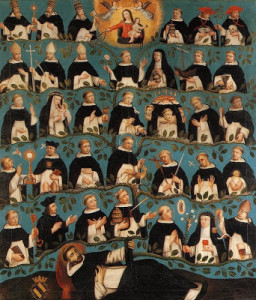
This year the Church will begin the Year of Consecrated Life highlighting the lives of service to God’s people of monks, nuns, sisters, friars, and orders of priests as well as the men and women in secular institutes and societies of apostolic life. The Year for Consecrated Life officially begins on November 30, 2014, the first Sunday of Advent. Pope Francis has called for a special yearlong focus on consecrated life, asking the Church’s religious sisters, brothers and priests to “wake up the world” with their testimony of faith, holiness and hope. It will end on February 2, 2016, the World Day of Consecrated Life.
The secular press freely tosses about terms like nun, sister, priest, monk without really knowing what they are specifically referring to. So, for the upcoming Year of Consecrated Life, here are some definitions which may serve as a helpful guide to distinguish the different forms of consecrated life:
Monk: a member of a community of men, usually contemplative, under the vows of poverty, chastity, and obedience, living according to the Order’s Rule. Examples: Benedictines (including Cistercians, Trappists), Carthusians, and Camaldolese.
Nun: a woman under solemn vows (eg. poverty, chastity, obedience) living in a cloistered, contemplative religious community. Examples: Poor Clares, Carmelites, Benedictines, Passionists. See www.cloisteredlife.com
Sister: a generic term for a religious woman whether cloistered or a member of a congregation under simple vows. Sisters are part of a spiritual family, share possessions in common and live together in Christ-like charity. Examples: Franciscans, Little Sisters of the Poor, Olivetan Benedictines
Friar: from the Latin word frater (brother). Friars are members of the mendicant orders. Unlike monks, friars engage in work outside of the monastery. Examples: Dominicans (Friars Preachers), Franciscans (Friars Minor), Carmelites (White Friars).
Diocesan Priests: men ordained by a Catholic bishop to preach the Gospel and administer the Sacraments of the Church in a particular diocese. They make three promises at ordination: to pray the Liturgy of the Hours daily, to obey their bishop and to live a celibate lives.
Canons Regular: priests who have vowed themselves to the service of a particular parish or oratory along with other clergy, with whom they live a common, religious life of poverty, chastity, and obedience in a residence (eg. rectory, abbey) attached to a church under the authority of a superior. Distinct from monks, canons publicly pray the Liturgy of the Hours in common and administer the Sacraments in a particular church. Examples: Norbertines, Canons Regular of the Immaculate Conception, Canons Regular of St. John Cantius
Clerics Regular: religious institutes or orders whose members profess vows, live in community according to a rule approved by the Church, and engage in a variety of apostolic work. Unlike canons, they do not pray the Liturgy of the Hours in common to devote themselves more fully to apostolate work. Example: Jesuits, Camillians
Secular Institute: a society of consecrated life, clerical or lay, whose members profess the evangelical counsels. Its members are not bound to live a common life but strive for the perfection of charity and work for the sanctification of the world especially from within. Examples: Father Kolbe Missionaries of the Immaculata, Schoenstatt Fathers & Sisters. See www.secularinstitutes.org
Societies of Apostolic Life: its members, without religious vows, are dedicated to pursuit of an apostolic purpose, such as educational or missionary work, and lead a life as brothers or sisters in common according to a particular manner of life and strive for the perfection of charity through the observance of the constitutions. Examples: Oratorians of St. Philip Neri, Daughters of Charity.
Consecrated Virgins & Widows: one of the ancient forms of consecrated life whose roots are found in the New Testament. These are women who, with the Church’s approval, live in the respective states of virginity or perpetual chastity “for the sake of the Kingdom of heaven.” Consecrated virgins are consecrated to God by the diocesan bishop according to the approved liturgical rite (Consecratio Virginum), are betrothed mystically to Christ and “are dedicated to the service of the Church” (www.consecratedvirgins.org). Consecrated Widows are experiencing a resurgence and groups are forming to assist in the resurrection of this form of consecrated life.
Hermits/Anchorites/Eremites: those dedicated to God in a consecrated life, professing the three evangelical counsels, confirmed by a vow or other sacred bond, in the hands of the diocesan bishop, and observing his or her own plan of life under the bishop’s direction and approval.
Comments and corrections and clarifications welcome!!
(The image is from the monastery of the Dominican Nuns at Estavayer le Lac, Switzerland, founded in 1280. The Dominican nuns have continually praised God in that location for almost 750 years.)